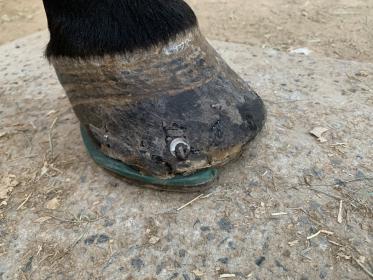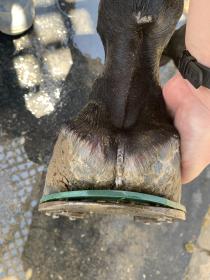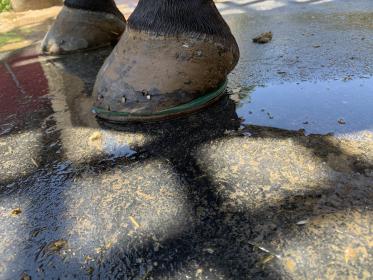Wow.
It would be very hard to argue how this could not be a case of farrier-made laminitis.
What a chronically unhealthy trim, with some really bad angles. You can see the fever rings at the top of the hoof; by the time you see these show up, generally whatever event it was that triggered them was months ago – but fever rings commonly show up in low grade laminitis (as in “simple” inflammation of the laminae) and can happen for any number of reasons, including fever, too much concussion, improper trim, and even something like constantly stomping from flies. Generally if you see the fever rings, it might be time to critically assess the hoof - as it is usually a sign of low grade inflammation within the hoof.
What a long toe, with serious flare; I would not be surprised to see the x-ray showed a negative plantar angle. At the very least, you likely had almost no sole there because as the toe becomes longer, the sole distends and stretches out to accommodate the longer toe.
It is always a red flag when you see coronary band distortion, such as seen in both front hooves there – the coronary band should, barring trauma to the site, always be relatively level from heel to the front of the pastern, and the hoof itself should follow a similar slope as the pastern. So any time you see jamming of the coronary band, that is a sign of chronic distress within the hoof.
Regarding developing your eye to NPA; always look at the profile of the hoof (from the side). It should be level and follow the slope of the pastern (some variation, depending on conformation, is ok) - any time you see the hoof “bulge” forward or demonstrate a bullnosed profile, it is very likely that the plantar (front) or palmar (hind) angle in the hoof has dropped, therefore become negative – which then places stress on the surrounding structures of the hoof; sole, coffin, even suspensory apparatus gets involved (and not uncommon at all, for a horse with suspensory injuries to have an NPA behind or up front).
I am so sorry you are going through this. We trust the professionals in our lives to be the experts of their profession – but it seems all too often in the farriery field that a good farrier is far from a dime a dozen.
Hope you can turn this around, glad to hear you have moved and gone with a new farrier. The backwards shoe is common in mechanical laminitis (“road founder”) to help support the heel while getting some pressure off of the toe.
There was minor separation in the x-rays? No sinking?
I have unfortunately gone through this myself, with a few boarder horses. Other than getting a new farrier, some of the best things you can do is bed the stall up to the nines; unfortunately for horses this is usually a time when they should definitely be kept in a stall for at least the first month… And, if your vet has not mentioned it, see if your vet advises isoxsuprine. While I don’t remember there being much evidence it helped clinically in laminitis cases, I do remember this was always prescribed by vets during laminitic events. Icing during the first few weeks can be helpful.
Jingling for you and your boy.





